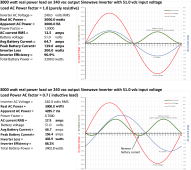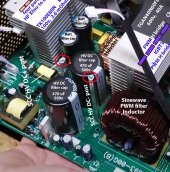Warpspeed
Solar Wizard
Low voltage rated mosfets win hands down when run at low voltages.
The "on" resistance is so very low, nothing else even comes close for conduction losses and speed.
But as the voltage rating of the mosfet increases, the "on" resistance rises much faster. High voltage mosfets are pretty miserable devices.
As RC above ^^ says, these days anything that runs over about 100v to 150v that also must run at reasonably high power, will likely be an IGBT.
Over the last ten years or so, IGBTs have massively improved in both speed and conduction losses.
You will find that all the high voltage grid tie inverters run IGBTs, never mosfets.
There is still a place for mosfets in an off grid inverter running at 48v, they are still by far the best choice for high frequency pwm at lower voltages.
These big IGBT power bricks are very slow, especially the older ones, and quite unsuitable for high frequency pwm, except in variable frequency drives where the pwm might be only a very few Khz or even hundreds of Hz. But they are perfect for switching very high power at 50/60Hz.
There is also another aspect of this that nobody talks about. These big devices may be rated for hundreds of amps, and the voltage drop across the IGBT might be a couple of volts, which is really too high for a low voltage inverter. But at much lower power, say ten or twenty amps, the voltage drop is actually quite low. Not as low as a low voltage mosfet, but acceptably low for an off grid inverter.
After building this monster and running it at 100v dc over four years, I would have no hesitation building another one to run at 48v using the exact same IGBTs.
With average mixed continuous domestic loads, which are mostly below 1Kw, the inverter efficiency is really quite good, even with IGBTs.
For really high power, a hundred dc amps is probably the practical maximum, say 5Kw at 48v. If you go up to 100v its only fifty amps and the losses from voltage drops around the system will be far lower. The only practical difficulty with high dc voltage becomes the large number of battery cells to maintain. But on the whole, I am very happy how my 100v system has worked out.
The "on" resistance is so very low, nothing else even comes close for conduction losses and speed.
But as the voltage rating of the mosfet increases, the "on" resistance rises much faster. High voltage mosfets are pretty miserable devices.
As RC above ^^ says, these days anything that runs over about 100v to 150v that also must run at reasonably high power, will likely be an IGBT.
Over the last ten years or so, IGBTs have massively improved in both speed and conduction losses.
You will find that all the high voltage grid tie inverters run IGBTs, never mosfets.
There is still a place for mosfets in an off grid inverter running at 48v, they are still by far the best choice for high frequency pwm at lower voltages.
These big IGBT power bricks are very slow, especially the older ones, and quite unsuitable for high frequency pwm, except in variable frequency drives where the pwm might be only a very few Khz or even hundreds of Hz. But they are perfect for switching very high power at 50/60Hz.
There is also another aspect of this that nobody talks about. These big devices may be rated for hundreds of amps, and the voltage drop across the IGBT might be a couple of volts, which is really too high for a low voltage inverter. But at much lower power, say ten or twenty amps, the voltage drop is actually quite low. Not as low as a low voltage mosfet, but acceptably low for an off grid inverter.
After building this monster and running it at 100v dc over four years, I would have no hesitation building another one to run at 48v using the exact same IGBTs.
With average mixed continuous domestic loads, which are mostly below 1Kw, the inverter efficiency is really quite good, even with IGBTs.
For really high power, a hundred dc amps is probably the practical maximum, say 5Kw at 48v. If you go up to 100v its only fifty amps and the losses from voltage drops around the system will be far lower. The only practical difficulty with high dc voltage becomes the large number of battery cells to maintain. But on the whole, I am very happy how my 100v system has worked out.







